Childcare providers and inspections as at 31 December 2016
Updated 26 August 2021
This release contains:
- the number of Ofsted registered childcare providers and places, and their most recent inspection outcomes as at 31 December 2016
- the number of providers that have registered with Ofsted (joiners) and the number of providers that have left (leavers) between 31 August 2016 and 31 December 2016
The number of childminders registered with Ofsted has continued to decrease
There were 44,000 childminders registered with Ofsted as at 31 December 2016, down 700 from 31 August 2016. Overall, childminder numbers have fallen by 23% since 31 August 2012. The number of non-domestic providers has remained stable at 26,900 over the last 4 months, but is down 3% since 31 August 2012.
The number of childcare places offered on the Early Years Register (EYR) has increased slightly
Despite decreasing numbers of providers on the EYR, the number of childcare places has remained broadly stable since August 2012. In the last 4 months, while childminder places have decreased, there has been a slight increase in the number of places overall due to a rise in places offered by childcare on non-domestic premises. There are currently almost 1.3 million places on offer.
More than 9 in 10 providers on the EYR were judged to be good or outstanding
As at 31 December 2016, the proportion of childcare providers on the EYR judged to be good or outstanding was 93% (Chart 1). This is up from 91% since 31 August 2016 and up from 74% since 31 August 2012. This rise is mostly due to an increase in the proportion of providers judged good.
Breaking down by provider type, the proportion of providers of childcare on non-domestic premises judged good or outstanding has remained at 95% since 31 August 2016, whereas the proportion of childminders has risen by 2 percentage points to 91%.
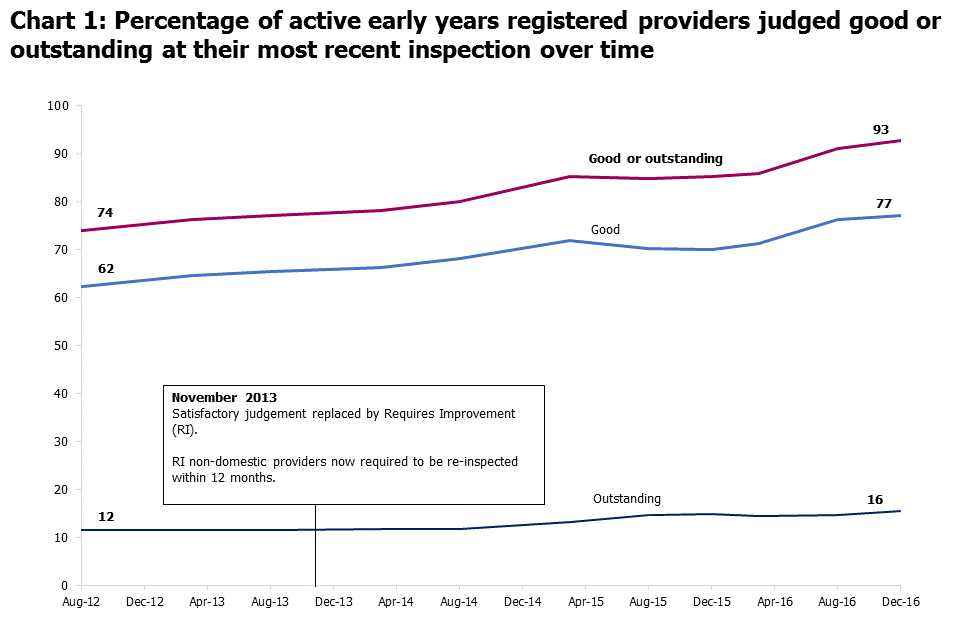
1. Introduction
Childcare providers can be registered with Ofsted on either or both of 2 registers.
The Early Years Register (EYR)
For all providers of childcare for children aged 0–5 years, registration on the EYR is compulsory and they must meet the requirements of the Early Years Foundation Stage (EYFS). There are some exceptions, such as nannies and provision for 2-year-olds at schools.
Childcare Register (CR)
The CR is split into 2 parts. The Compulsory Childcare Register (CCR) is for providers caring for children aged 5–7 years. The Voluntary Childcare Register (VCR) is for providers who would like to register but are not required to, such as childminders who only look after children aged 8 or above, or nannies.
Childcare provision is made up of 4 separate provider types.
Childminder
This is a person who is registered to look after one or more children, to whom they are not related, on a domestic premises for reward. The majority are on the EYR (this enables them to look after children aged 0 to 5).
Childcare on non-domestic premises
Childcare providers on non-domestic premises mainly comprise nurseries and pre-schools. They also include breakfast clubs, after-school clubs, summer clubs and crèches. In general, nurseries and pre-schools register on the EYR whereas crèches are more likely to be registered only on the CR.
Childcare on domestic premises
If 4 or more people look after children at any one time in someone’s home, they are providing childcare on domestic premises. There are only a relatively small number of providers of this type, compared with the other three types. The majority are on the EYR.
Home childcarer
Home childcarers are usually nannies who care for children aged 0-18 wholly or mainly in the child’s own home. Home childcarers are not required to register with Ofsted but may choose to do so on the VCR.
More contextual information is available in the glossary in the word or PDF version of the key findings.
2. Number of providers
There were 81,800 childcare providers registered with Ofsted as at 31 December 2016. This represents a decrease of 1% since 31 August 2016, and a decrease of 15% since 31 August 2012, when there were 96,200 providers. Figures are quoted to the nearest 100.
Childminders (Chart 2)
There were 44,000 providers as at 31 December 2016, down 700 from 31 August 2016. This continues a downward trend of 23% since 31 August 2012.
Childcare on non-domestic premises (Chart 2)
There were 26,900 providers as at 31 December 2016, the same as seen as at 31 August 2016. Numbers have decreased by 3% since 31 August 2012.
Home childcarers (Chart 2)
There were 10,800 providers as at 31 December 2016, down by over 100 from 31 August 2016. Numbers are at a similar level to those seen at as at 31 August 2012. There was a rise in numbers in 2013, peaking at 12,100 as at 31 August 2013, followed by a steady year-on-year fall.
Childcare providers on domestic premises
They are not included here as there are only a relatively small number. In England, there were 204 as at 31 December 2016.
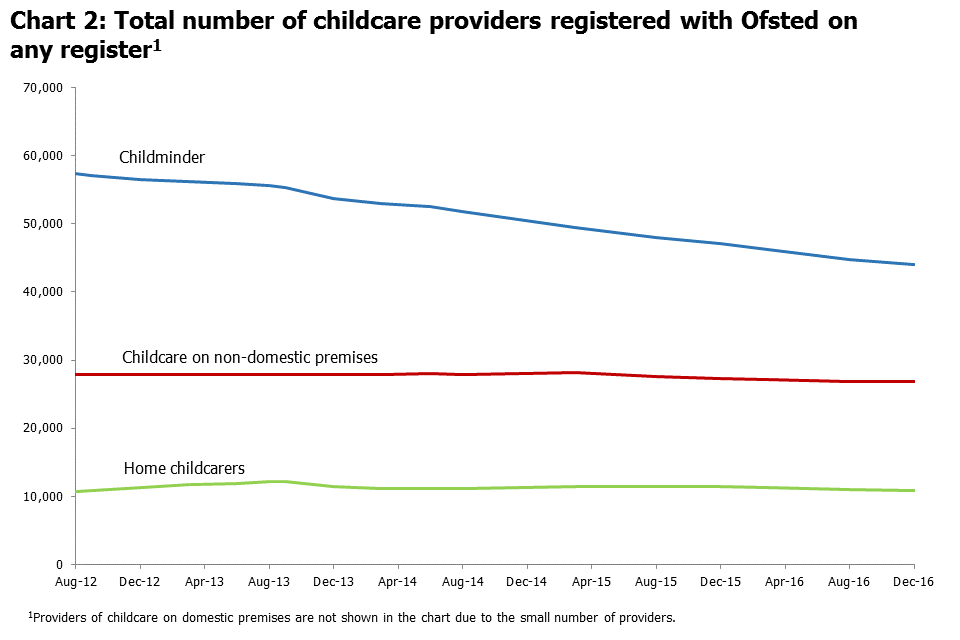
In summary, the number of providers in the childcare sector has decreased steadily since August 2012. This has been driven by a large decrease in the number of childminders, a more modest decrease in the number of non-domestic providers, and no overall change in the number of home childcarers.
Looking at the large decrease in childminder numbers over time, this is mainly driven by fewer childminders joining the sector, while the number leaving the sector remained broadly constant. In the last 4 months of 2016, 1,400 childminders joined the sector and 2,200 childminders left. In comparison, in the 3 months between 30 June 2012 and 30 September 2012 (a shorter time period) 2,000 childminders joined the sector and 2,200 childminders left. A 3-month time period is used for 2012 as a comparison because historically Ofsted published information quarterly. Data over a 4-month time period was not published at that time. While there were broadly similar numbers of leavers in these 2 time periods, there were fewer joiners in 2016 than in 2012.
The modest decrease in the number of providers of childcare on non-domestic premises may be related to a change in registration policy. Since May 2015, schools have been exempt from registering their early years provision for 2-year-olds. This means that many schools that provide childcare for 2-year-olds are not registered with Ofsted. This may have contributed to the 2% decrease in the number of providers of childcare on non-domestic premises from 31 August 2015 to 31 December 2016.
With regard to inspections, Ofsted school inspections look at early years provision where it is provided in a school, and schools receive a separate inspection sub-judgement for this. School inspections are not covered in this release, but information is available at ‘Maintained schools and academies inspections and outcomes official statistics’.
Regional analysis
Looking at the percentage decreases in the number of providers over time, the largest range across the regions was seen for home childcarers; the smallest of the 3 main provider types. The decrease in the number of home childcarers since 31 August 2012 ranged from 4% in the South East to 16% in Yorkshire and The Humber.
The smallest range across the regions was seen for childminders; the largest provider type. Nationally the decrease was 23%, with the largest regional decrease in the West Midlands (27%) and the smallest in Yorkshire and The Humber (20%).
Larger ranges for smaller provider types are to be expected, as smaller population sizes tend to have more statistical variation than larger ones.
3. Number of places
Registers and places
As at 31 December 2016, 81% of childcare providers were on the Early Years Register (EYR). Most of these are also registered on the Childcare Register (CR). The remaining 19% were not on the EYR, and so only appear on the voluntary (VCR) or compulsory (CCR) parts of the CR.
As discussed in the introduction, places information is only recorded for providers on the EYR. Focusing on EYR places by provider type, the proportion of all childcare provided by childminders has decreased slightly over time. As at 31 December 2016:
- with an estimated 1.0 million places, 80% of all childcare places were offered by providers of childcare on non-domestic premises – an increase of 2 percentage points since August 2012
- with an estimated 257,000 places, the remaining 20% were offered by childminders – a decrease of 2 percentage points since August 2012
- less than 1% of places were offered by providers of childcare on domestic premises, with an estimated 4,000 places
Percentages do not sum to 100 due to rounding.
Despite decreasing numbers of providers, the number of childcare places has remained broadly stable since August 2012 (Chart 3). In the last 4 months, while childminder places have decreased, there has been a slight increase in the number of places overall due to a rise in places offered by childcare on non-domestic premises. There are currently almost 1.3 million EYR places on offer in the childcare sector.

When analysing places data, it is important to note that:
- while the majority of providers have places information recorded on the EYR, for some providers we have calculated estimates (for more information on the estimation process, see ‘Number of places’ in the glossary in the word or PDF version of the key findings)
- the number of places offered by a provider is the legal maximum number of children they can provide childcare for at any one time
- for non-domestic providers, the number of places is likely to reflect the number of children they intend to provide childcare for
- for childminders, around 70% are registered as offering 6 places (the maximum number of places allowed under EYFS guidelines for childminders with no assistants), however, the number of places childminders provide or intend to provide is likely to be lower
This increase in childminder places may be due in part to a change in the conditions of registration with the EYFS update in September 2012. Since this update, providers have been required to return details on the number of places they offer at the point of registration, and the majority of childminders with no assistants register the maximum of 6 places. Prior to this, places information was only derived from the conditions of registration that applied at the time.
In summary, while the number of childminder places has decreased by 9% since August 2012, the decrease may have been higher if there had not been a change in the registration process. As new childminders registering are more likely to declare 6 EYR places, this may lead to an overestimate in the total number of childminder places, and this effect may become more pronounced over time.
Providers and places
Interestingly, while childminder provider numbers have decreased by 23% since 31 August 2012, childminder places have only decreased by 9%, with the average number of places offered by childminders increasing. As at 31 August 2012, the average number of places offered by childminders was 5.1, whereas as at 31 December 2016, the average was 6.1. This average takes into account childminders who have assistants, who are permitted to offer more than 6 places.
The interest in the number of places offered in the childcare sector is likely to increase this year as we approach the introduction of 30 hours free childcare for working families in England from September 2017.
4. Inspection outcomes
New providers joining the EYR are normally inspected within 30 months of registration. Please see ‘Being inspected as a childminder or childcare provider’ for more information about the process of being inspected as a childcare provider. As at 31 December 2016, of the 66,500 providers on the Early Years Register (EYR), 82% had been inspected, with the remaining 18% yet to be inspected.
Proportion of providers on the EYR judged good or outstanding
As at 31 December 2016, the proportion of childcare providers on the Early Years Register (EYR) judged to be good or outstanding was 93%. This is up from 91% as at 31 August 2016, continuing an upward trend over the last 4 years. The increase can be attributed to the steady rise in the proportion of providers judged good, with only a small increase in the proportion of providers judged outstanding (Chart 1).
Looking at the 2 main provider types, 95% of providers of childcare on non-domestic premises were judged to be good or outstanding at their most recent inspection, which was the same proportion as at 31 August 2016. For childminders, 91% were judged good or outstanding, up 2 percentage points from 89% as at 31 August 2016.
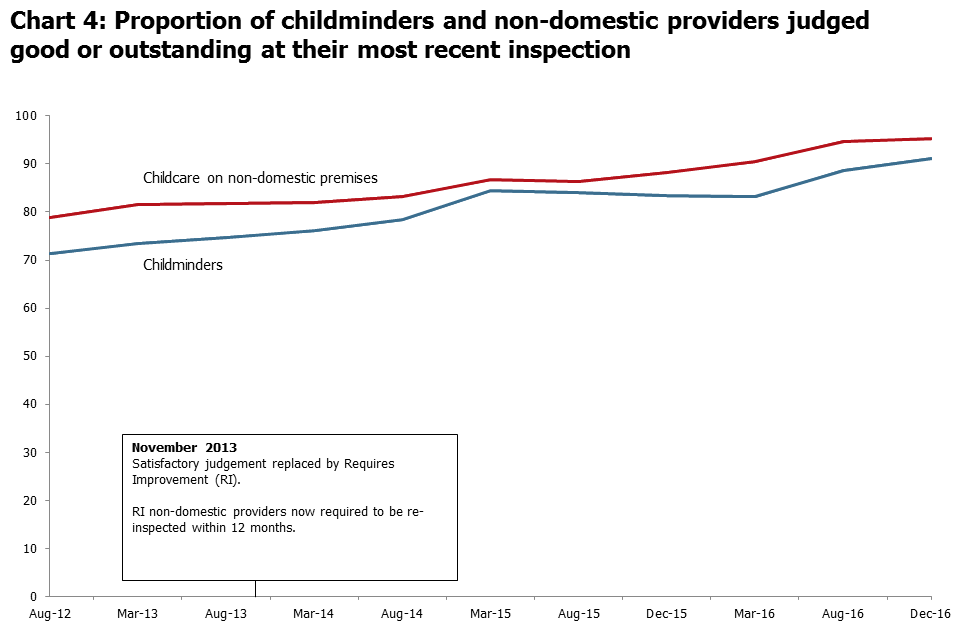
Changes in the proportion of childminders judged good or outstanding
The beginning of August 2016 saw the start of the new inspection cycle, with Ofsted prioritising childminders for inspection who had been previously judged requires improvement (RI) or inadequate.
Looking at these childminders who previously received a judgement of RI or inadequate, in the last 4 months of 2016, 80% improved to good or outstanding from RI or inadequate. This has a double effect – the number of good or outstanding childminders increases and the number of RI or inadequate childminders decreases. This is a key factor behind the recent improvement in the proportion of childminders judged good or outstanding. Other factors that have influenced this upward trend in the longer term are that:
- new providers are more likely to be judged good or outstanding at their first inspection than they were 4 years ago
- providers leaving the sector are more likely to have had inspection judgements of RI or inadequate than those that remain
Changes in the proportion of childcare on non-domestic premises judged good or outstanding
Since August 2012, the proportion of childcare on non-domestic premises judged good or outstanding has been increasing steadily. As with childminders, part of this increase can be explained by a change in the childcare inspection policy. From November 2013, all childcare on non-domestic premises judged requires improvement must be re-inspected within 12 months. See announcement of update in early years inspection policy from Her Majesty’s Chief Inspector in August 2013. This means that non-domestic providers have had more opportunity to demonstrate improvement than they did previously.
Regional inspection outcomes
The rise in the proportion of providers judged good or outstanding over time is seen across all of the 9 regions in England (Chart 5).
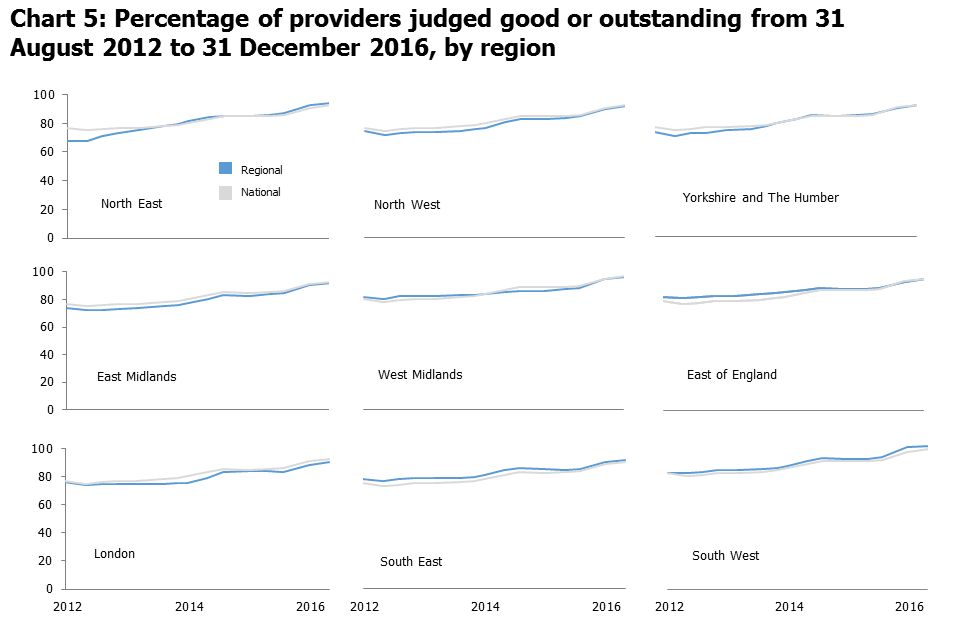
As at 31 December 2016, the proportion of all providers (EYR) judged good or outstanding was at its highest ever in all regions. The proportion was highest in the South West (95%) and lowest in London (90%).
On a national level, there was a 4 percentage point gap between the proportion of non-domestic providers judged good or outstanding (95%) and the proportion of childminders judged good or outstanding (91%). Across the regions, these gaps ranged from 2 percentage points in the South East to 6 percentage points in London (Chart 6).
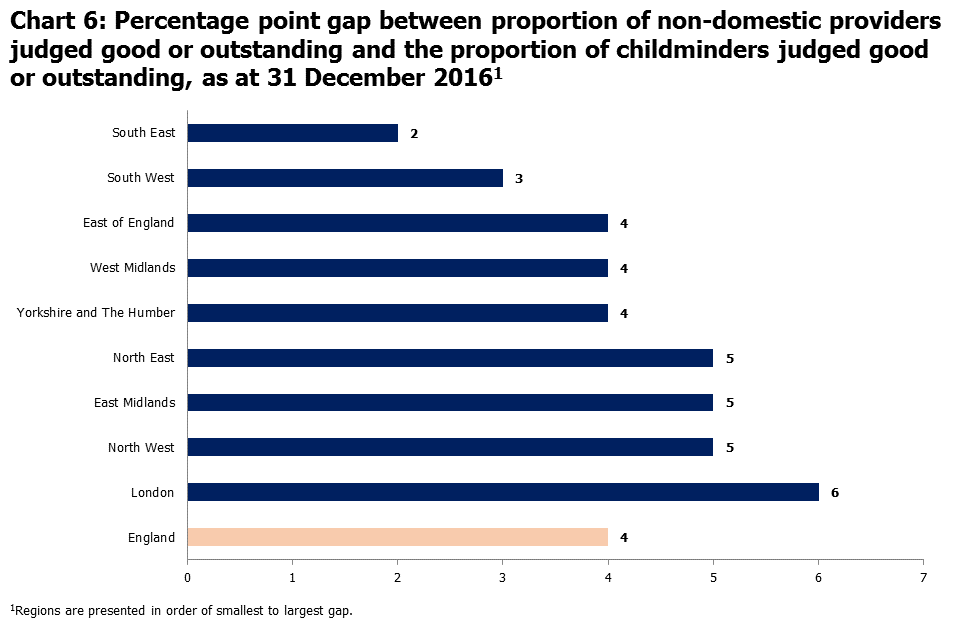
There is more regional variation in the inspection outcomes of childminders than non-domestic providers. Therefore, regional differences in the gap between the proportion of childminders and non-domestic premises judged good or outstanding are primarily driven by the proportion of childminders judged good or outstanding.
In the South East, 93% of childminders were judged good or outstanding, compared to 91% in England as a whole, and the gap between childminders and childcare on non-domestic premises in this region was only 2 percentage points. Conversely, in London the larger gap is due to a lower than average proportion of childminders judged good or outstanding, at 88%.
5. Childminder agencies
Childminder agencies were introduced in September 2014, enabling new childminders to choose to register with Ofsted directly or register with an agency. Existing childminders could also choose to deregister with Ofsted and register instead with a childminder agency.
As at 31 December 2016, 9 childminder agencies were registered with Ofsted and active. This is an increase of one since 31 August 2016. Of these 9 agencies, only one has been inspected and judged “Effective”.
Childminder agencies data is available on the provider level data file on the Official Statistics release page as at 31 December 2016.
6. Notes
An explanation about key uses of this data, further contextual information and the arrangements for quality assurance is provided in the methodology and quality report, which accompanies this release.
The methodology and quality report also provides information on the strengths and limitations of the statistics.
Revisions to previous release
The provisional data in the previous release related to inspections between 1 April 2016 and 31 August 2016, published as at 30 September 2016. A revised list of inspections in this period is provided in the ‘Childcare providers and inspections charts and tables’ document for this release in Tables 14-19, which include inspections that were published as at 31 January 2017.
These revisions did not result in any changes to the key findings identified in the previous publication.
Revisions to data in this publication are published in line with Ofsted’s revisions policy for official statistics.
Common Inspection Framework (CIF)
Inspections from 1 September 2015 were carried out under the Common Inspection Framework (CIF), such that the inspection judgements are common across the Early Years, Schools and Further Education and Skills remits. Ofsted evaluates the overall quality and standards of the early years provision in line with the principles and requirements of the EYFS. Inspectors judge the overall effectiveness of the early years provision, taking into account 4 key judgements:
- quality of teaching, learning and assessment
- personal development, behaviour and welfare
- effectiveness of leadership and management
- outcomes for children
Ofsted is required to inspect all providers who were on the Early Years Register (EYR) on 1 August 2016 at least once by 31 July 2020. Providers who have registered after this date will normally be inspected within 30 months of registration.
7. Further information
Ofsted publishes the following information on the inspection of early years providers:
- early years and childcare statistics
- common inspection framework education skills and early years from september 2015
- regulation of services on the childcare register
Contact for comments or feedback
If you have any comments or feedback on this publication, please contact Nick Woodhill on 03000 130 411 or Nick.Woodhill@ofsted.gov.uk

